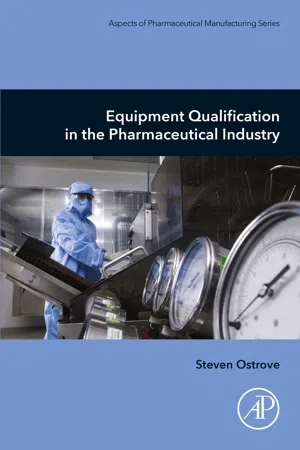
- 234 pages
- English
- ePUB (mobile friendly)
- Available on iOS & Android
Equipment Qualification in the Pharmaceutical Industry
About this book
Equipment Qualification in the Pharmaceutical Industry provides guidance and basic information for the preparation of a quality qualification program. It has been noted that there is a general lack of understanding in the industry, especially for those new to the industry, as to what constitutes a compliant qualification program. Even experienced professionals have felt a lack of security in reaching a compliant state. This book outlines a guideline for the preparation and execution of qualification protocols including the installation (IQ), operational (OQ), and performance (PQ) protocols. It discusses the importance of related qualification programs (e.g., quality systems, commissioning, computer system, and cleaning) and how to incorporate them into a fully compliant qualification program. Furthermore, it provides matrices of what could be included in each type of protocol for major types of process equipment. While primarily for people entering the pharmaceutical industry, those established in the field will benefit from the multiple examples and matrices as well as integration of related systems.Equipment Qualification in the Pharmaceutical Industry provides students and pharmaceutical scientists a guideline for the preparation and execution of qualification (installation, operational, and performance) protocols.- Incorporates good manufacturing processes into a compliant qualification program- Provides examples of protocol layout- Includes matrices for major process equipment, installation quality, operational quality, and performance quality requirements
Frequently asked questions
- Essential is ideal for learners and professionals who enjoy exploring a wide range of subjects. Access the Essential Library with 800,000+ trusted titles and best-sellers across business, personal growth, and the humanities. Includes unlimited reading time and Standard Read Aloud voice.
- Complete: Perfect for advanced learners and researchers needing full, unrestricted access. Unlock 1.4M+ books across hundreds of subjects, including academic and specialized titles. The Complete Plan also includes advanced features like Premium Read Aloud and Research Assistant.
Please note we cannot support devices running on iOS 13 and Android 7 or earlier. Learn more about using the app.
Information
Introduction
Abstract
Keywords
- • Why do we need to qualify the equipment?
- • Who can or who does the qualification?
- • What needs to be qualified?
- • What is qualification?
- • How much is it going to cost?
- • How long will it take?
- • Compliance
- • Qualification
- • Validation
Compliance
- • “…the action or fact of complying with a wish or command”
- • “… the state or fact of according with or meeting rules or standards”
Qualification
- • “a condition or standard that must be complied with”f
Validate/validation
- • to make legally
- • to support or corroborate on a sound or authoritative basis
- • to give legal force to; legalize
- • to give official sanction, confirmation, or approval to, as elected officials, election procedures, documents, etc.
- For example, you purchase a new toaster. First the box is inspected, intact, and not damaged. Then the unit is removed from the box and placed on the counter. Question, is it what you expected the unit to be? Does it have two slots or four? The unit is then plugged in, and a piece of bread is inserted into one of the slots. The toast level is set, and the bread plunger is depressed. When it pops out, you check it for the level of darkness you like. Repeat as necessary (commissioning) until it is correct.
Table of contents
- Cover image
- Title page
- Table of Contents
- Copyright
- Dedication
- Acknowledgments
- Introduction to aspects in pharmaceutical manufacturing
- Chapter One: Introduction
- Chapter Two: Getting ready: Documentation
- Chapter Three: Quality systems
- Chapter Four: Equipment design considerations
- Chapter Five: Equipment controls and automation
- Chapter Six: Preparing the protocols: General approach
- Chapter Seven: Commissioning and decommissioning
- Chapter Eight: Equipment qualification protocols
- Chapter Nine: Equipment checklists
- Chapter Ten: Protocol execution
- Chapter Eleven: Protocol reports
- Appendix A: Definitions and abbreviations
- Appendix B: Preparing a Qualification Protocol
- Appendix C: References
- Index